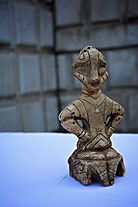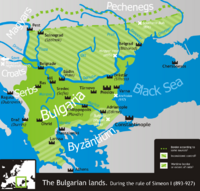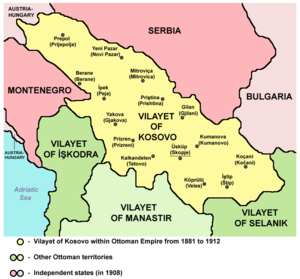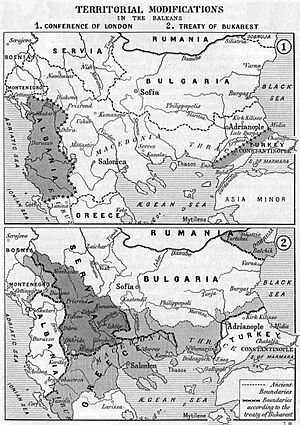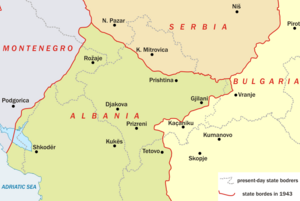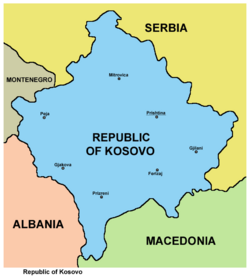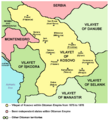History of Kosovo facts for kids
The history of Kosovo goes back to ancient times, long before written records. Early cultures like the Starčevo, Vinča, Bubanj-Hum, and Baden lived here. Many old sites have been found because the area had lots of natural resources, which helped people settle and grow.
In ancient times, Kosovo was part of the Kingdom of Dardania. The Roman Empire took control around the end of the 1st century BC, making it part of their province called Moesia. During the Middle Ages, Kosovo became part of the Bulgarian Empire, the Byzantine Empire, and later, the Serbian medieval states. A very important event was the Battle of Kosovo in 1389, where Balkan states fought the Ottoman Empire. This battle led to the Ottomans taking over Kosovo by 1459.
Kosovo's modern history began with the Ottoman Sanjak of Prizren. Parts of it were organized into the Kosovo Vilayet in 1877. This was the first time "Kosovo" was used as the name for the whole area. In 1913, the Kosovo Vilayet became part of the Kingdom of Serbia, which later joined to form Yugoslavia in 1918. Kosovo gained some self-rule in 1963 under Josip Broz Tito. This self-rule became much stronger with Yugoslavia's 1974 Constitution but was lost in 1990. After a conflict in 1999, the UNMIK (United Nations Mission in Kosovo) stepped in. On February 17, 2008, Kosovo's leaders officially declared independence. They then adopted the Constitution of the Republic of Kosovo, which started on June 15, 2008.
Contents
Ancient Times: Prehistory and Early Kingdoms
People have lived in and around Kosovo for almost 10,000 years. During the Stone Age, there are signs that people lived in caves, like the Radivojce Cave. However, the earliest confirmed settlements in Kosovo date back to the Neolithic period, also known as the New Stone Age. From this time until today, people have continuously lived in Kosovo. Many archaeological sites show how societies developed from prehistoric times, through ancient periods, and into the Middle Ages. Some sites even show layers of settlements, proving that life continued there for centuries.
Two important Neolithic sites are Vlashnjë and Runik. Digs at Vlashnjë show people lived there since the Neolithic era. Rock paintings found at Mrrizi i Kobajës are the first prehistoric rock art discovered in Kosovo. Runik and Crkvina (in Serbia) are considered the oldest Starčevo culture settlements, dating back to around 6200 BC.
The Dardanians and Roman Rule
In ancient times, the Kosovo area was part of Dardania. This name comes from the Dardani, a tribe who lived there and formed the Kingdom of Dardania in the 4th century BC. The Dardani became one of the strongest Illyrian groups under their king, Bardylis. He led them to defeat the Macedonians and Molossians many times.
The Roman Empire conquered the Illyrian region in 168 BC. The Kosovo area likely became part of the Roman province of Moesia Superior around 87 AD. Later, around 284 AD, the Roman emperor Diocletian divided Moesia Superior into smaller provinces, including Dardania. The capital of this Roman Dardania was Naissus. The Romans built several cities in the region.
The Hunnic invasions in the 5th century damaged many cities in the Balkans. Although there's no direct proof of Hunnic attacks in Kosovo, the region's economy would have been affected. Later, Justinian I, the Byzantine Emperor, brought Kosovo back into the Byzantine Empire in the 6th century.
Slavic Migrations
Slavic people began moving into the Balkans between the 6th and 7th centuries. They invaded the area of modern Kosovo in 547 and 548. Many towns in Kosovo today have Slavic names, which suggests that the Slavs either mixed with or replaced the local people living there before. The plague of Justinian had also reduced the population, leaving many areas empty and open for new settlers.
Some historians believe that Slavic settlement in Kosovo was not very strong in the first one or two centuries. This is because many old Latin place names in the area survived and were later changed into Slavic names, like Naissus becoming Nis.
Middle Ages: Empires and Kingdoms
Kosovo became part of the First Bulgarian Empire during the rule of Khan Presian (836–852). It stayed under Bulgarian control for about 150 years until 1018. Then, the Byzantine Empire took it back under Emperor Basil II. In 1072, Bulgarian leaders started an uprising and invited Mihailo Vojislavljević from Duklja to help. His son, Constantine Bodin, came with soldiers and defeated the Byzantine army near Prizren. Prizren was then looted. After this, Bodin was named "Emperor of the Bulgarians." However, the Byzantines soon defeated them and took control of Kosovo again.
Later, Stefan Nemanja of Serbia took control of the area around the White Drin river between 1185 and 1195. By 1219, the Nemanjić dynasty had fully established its rule in Prizren and Kosovo. Kosovo became a full part of the Serbian Empire (1346-1371). During this time, the Nemanjić rulers often lived in Kosovo. Many important churches and monasteries, like the Patriarchate of Peć and Visoki Dečani, were built then. Kosovo was also important for its silver mines in places like Novo Brdo. The population included Serbs, Albanians, and Vlachs, along with smaller groups like Greeks and Saxons.
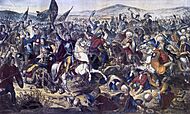
In 1355, after the death of Tsar Stefan Dušan, the Serbian state broke into smaller parts. This happened at the same time the Ottoman Empire was expanding. The famous Battle of Kosovo took place on June 28, 1389. Lazar Hrebeljanović, the Serbian prince, led a group of Christian soldiers from Serbia, Bosnia, Albania, and Hungary against the Ottoman army led by Sultan Murad I. Sultan Murad I was killed during the battle. While it's often seen as a big Christian defeat, some at the time thought it was a draw or even a Christian victory. Serbian leaders continued to rule, often as Ottoman vassals, until the Serbian state finally fell in 1459. After this, Serbia, including Kosovo, became part of the Ottoman Empire.
Ottoman Period
When the Ottomans fully took over, western Kosovo already had a large Albanian population. Over time, many local people in Kosovo converted to Islam, especially in towns. This was often for economic and social reasons, as Muslims had more rights than Christians. However, Christian religious life continued, and churches were mostly left alone, though they faced high taxes.
In 1557, the Serbian Patriarchate of Peć (a religious center) was re-established. By this time, the town of Peja itself might have had a Muslim majority. Records from the 17th century show that people in Western Kosovo spoke Albanian, while those in Eastern Kosovo spoke Serbo-Croatian.
During the Great Turkish War (1683-1699), some Albanians and Serbs joined the Austrians against the Ottomans. However, the Austrians were pushed back, leading to many refugees and suffering. After this, Serbian Patriarch Arsenije III Crnojević led many refugees, mostly from the Niš and Belgrade areas, to Hungary. This event is known as the Great Migrations of the Serbs.
Modern History: Autonomy and Independence
During Ottoman rule, Kosovo was divided into administrative districts. In 1877, the Vilayet of Kosovo was formed. This was the first time the name "Kosovo" was used for the entire territory. The name comes from the Serbian word "Kos," meaning "black bird," and refers to "Kosovo Polje" or "Field of the Blackbirds," where the 1389 battle took place.
The Vilayet of Kosovo was one of four areas with Albanian people that formed the League of Prizren. This League aimed to resist both Ottoman rule and the growing power of new Balkan nations. In 1910, an Albanian uprising began in Pristina and spread across Kosovo.
Albanian National Movement and Balkan Wars
The Albanian national movement grew because the Ottoman Empire was losing territory and wars. Between 1876 and 1878, many Albanians were forced to leave their homes in the Sanjak of Niš and fled to Kosovo. Also, the Treaty of San Stefano threatened to divide Albanian lands among Serbia, Montenegro, and Bulgaria.
To prevent their lands from being split up, Albanians formed the League of Prizren on June 10, 1878. The League aimed to create an Albanian region within the Ottoman Empire. It raised an army and fought to defend its lands. In 1881, a temporary government was formed. However, military actions by Balkan states and the Ottomans eventually ended the League.
Another Albanian organization, the League of Peja, was founded in 1899. It also sought an autonomous Albanian region. Its leader, Haxhi Zeka, was later assassinated.
In the early 20th century, Albanian demands for their language to be used in government and education led to more uprisings. In 1912, a major Albanian rebellion weakened the Ottoman Empire. This encouraged Greece, Serbia, Montenegro, and Bulgaria to start the First Balkan War against the Ottomans. Most of Kosovo was then taken by the Kingdom of Serbia, and the Metohija region was taken by the Kingdom of Montenegro. The majority of people in Kosovo were Albanian and did not welcome Serbian rule. Many Albanians continued to resist, fighting for Kosovo to unite with Albania.
Between the World Wars
From 1918 to 1929, during the Kingdom of Serbs, Croats and Slovenians, the Serbian population in Kosovo grew, while the non-Serbian population declined. Serbian troops tried to change the population mix by expelling Albanians. Between 1918 and 1945, over 100,000 Albanians left Kosovo. Albanian schools and language were banned. Land was taken from Albanian villagers, and tens of thousands of Serbs were settled in the region.
Second World War
After the Axis powers invaded Yugoslavia in 1941, most of Kosovo became part of Italian-controlled Albania. The rest was controlled by Germany and Bulgaria. During the war, there were conflicts between different ethnic groups and ideologies. Thousands of Albanians and Serbs were killed. Many Serb and Montenegrin settlers were expelled or sent to concentration camps.
At the end of 1943, Albanian and Yugoslav partisans met and agreed that Kosovo should have the right to decide if it wanted to stay with Albania or join Serbia. However, Yugoslavia did not honor this agreement. Some Albanians revolted against the Yugoslav communists, but they were met with violence.
Yugoslavian Period
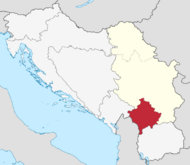
After World War II, Kosovo became an autonomous region of Serbia in 1946, and then an autonomous province in 1963 within Communist Yugoslavia. The government did not allow all refugees to return.
With the 1974 Yugoslavian constitution, Kosovo gained almost complete self-rule. The provincial government used Albanian textbooks in schools. However, during the 1980s, tensions grew between Albanian and Serb communities. Albanians wanted more self-rule, while Serbs wanted closer ties with Serbia. In 1981, Albanian students in Pristina protested for better living conditions and for Kosovo to become a republic within Yugoslavia. These protests turned into riots and were put down harshly.
Serbs living in Kosovo felt discriminated against by the local government. In 1988 and 1989, Serbian politicians began to reduce the autonomy of Kosovo. In protest, Kosovo Albanians held large demonstrations and miners went on hunger strike. The new constitution greatly reduced Kosovo's rights, giving Serbia direct control over police, courts, economy, and education. Many minorities in Serbia opposed this. Despite not getting enough votes, the changes were declared passed.
Kosovo War (1998-1999)
After the constitutional changes, Kosovo Albanians refused to take part in official elections and held their own, which were not recognized by Serbia or other countries. Albanian-language media in Kosovo was suppressed, and funding was cut. Many Albanian workers were fired from government jobs and schools in 1990, leading to strikes and unrest.

Albanians were very upset by these changes. After protests and violence, a state of emergency was declared in February 1990. The Yugoslav Army and police increased their presence.
Initially, Ibrahim Rugova promoted peaceful resistance. But later, the Kosovo Liberation Army (KLA) began an armed campaign from 1996. The KLA used guerrilla tactics and attacks against Yugoslav security forces, officials, and even Albanians who didn't support them. In March 1998, the Yugoslav army and Serbian police joined forces to fight the separatists. Thousands of Albanian civilians were killed, and many fled their homes. By March 1999, about 460,000 people had been displaced. There was also violence against non-Albanians, and many Serbs left their homes.
After talks failed, North Atlantic Treaty Organization (NATO) intervened on March 24, 1999, without UN approval. NATO launched bombing campaigns against Yugoslav military targets. A full-scale war broke out, with the KLA attacking Serbian forces and Serbian/Yugoslav forces fighting the KLA. Many human rights groups called the displacement of Kosovo's population "ethnic cleansing" by government forces.
Independence
The war ended on June 10, 1999, when the Serbian and Yugoslav governments signed the Kumanovo Agreement. This agreement transferred control of Kosovo to the United Nations. A NATO-led force called KFOR entered Kosovo to provide security. In the weeks after the war, many non-Albanians, especially Serbs and Roma, fled Kosovo fearing revenge. Thousands more were forced out by threats and crime.
In 2004, unrest in Kosovo led to deaths and the destruction of homes and Serbian Orthodox churches. This caused thousands more Kosovo Serbs to leave their homes.
International talks began in 2006 to decide Kosovo's final status. Most of Kosovo's population wanted independence, while Serbia wanted to keep its control. The UN-backed talks, led by Martti Ahtisaari, did not lead to an agreement between Serbia and Kosovo.
On February 17, 2008, Kosovo officially declared its independence. It then adopted its own constitution, which came into effect on June 15, 2008. Some Kosovo Serbs who opposed independence tried to take control of infrastructure in Serb-populated areas. There have been occasional acts of violence against international and government institutions, especially in Northern Kosovo.
In 2013, Serbia and Kosovo reached the Brussels Agreement, which allowed the Serb minority in Kosovo to have its own police force and court. In April 2021, Vjosa Osmani was elected as Kosovo's new president.
In September 2021, Serbs in northern Kosovo blocked roads to protest a ban on cars with Serbian license plates. Serbia responded with military exercises. An agreement was reached to end the standoff. Tensions rose again in July 2022 over identity documents and license plates. In November, ethnic Serbs resigned from Kosovo institutions in protest, and tensions continued.
Images for kids
-
Stefan Dušan briefly held court in the region of Prizren.
-
Monument to Serbian victims in Mitrovica.
-
14th-century icon from UNESCO World Heritage Site Our Lady of Ljeviš in Prizren, damaged in 2004.
See also
 In Spanish: Historia de Kosovo para niños
In Spanish: Historia de Kosovo para niños
- Demographic history of Kosovo
- History of Albania
- History of Serbia
- History of Yugoslavia
- History of the Balkans
- History of Europe


